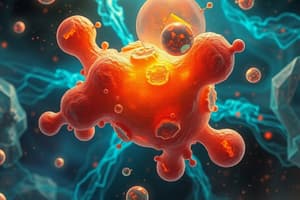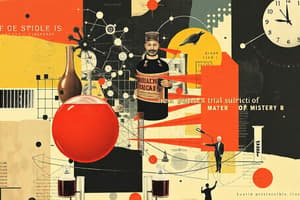Podcast
Questions and Answers
Which of the following is a mixture?
Which of the following is a mixture?
- Oxygen
- Tea (correct)
- Helium
- Gold
A substance with definite volume but no definite shape is a solid.
A substance with definite volume but no definite shape is a solid.
False (B)
What is the chemical symbol for potassium?
What is the chemical symbol for potassium?
K
Elements in group 1 are known as ___________ metals.
Elements in group 1 are known as ___________ metals.
Match the following elements with their classification:
Match the following elements with their classification:
Tap water is best described as which of the following?
Tap water is best described as which of the following?
Which of the following is classified as a compound?
Which of the following is classified as a compound?
All the following are homogeneous mixtures except which one?
All the following are homogeneous mixtures except which one?
A pure substance has a variable chemical composition.
A pure substance has a variable chemical composition.
Describe the main difference between a homogeneous and heterogeneous mixture.
Describe the main difference between a homogeneous and heterogeneous mixture.
An atom is the smallest unit of an ______.
An atom is the smallest unit of an ______.
Match the following types of matter with their descriptions:
Match the following types of matter with their descriptions:
Which of the following is NOT typically provided on the periodic table given for the test?
Which of the following is NOT typically provided on the periodic table given for the test?
Which of the following is the correct location of protons in an atom?
Which of the following is the correct location of protons in an atom?
The mass number of an atom is equal to the number of electrons in its nucleus.
The mass number of an atom is equal to the number of electrons in its nucleus.
How many valence electrons does an alkali metal in period 2 have?
How many valence electrons does an alkali metal in period 2 have?
The atomic number of an atom indicates the number of ______ in the atom.
The atomic number of an atom indicates the number of ______ in the atom.
Given the atomic number and mass number of an atom, what is the number of neutrons in it?
Given the atomic number and mass number of an atom, what is the number of neutrons in it?
If an element has 17 protons, 18 neutrons, and 17 electrons, what is the element's mass number?
If an element has 17 protons, 18 neutrons, and 17 electrons, what is the element's mass number?
Which of the following best describes the number of protons, electrons, and neutrons in a hydrogen-2 isotope?
Which of the following best describes the number of protons, electrons, and neutrons in a hydrogen-2 isotope?
Match the subatomic particle with its corresponding charge:
Match the subatomic particle with its corresponding charge:
Flashcards
Element
Element
A substance that cannot be broken down into simpler substances by chemical means.
Compound
Compound
A substance composed of two or more elements chemically combined in a fixed ratio.
Mixture
Mixture
A combination of two or more substances that are not chemically combined.
Homogeneous Mixture
Homogeneous Mixture
Signup and view all the flashcards
Heterogeneous Mixture
Heterogeneous Mixture
Signup and view all the flashcards
Pure Substance
Pure Substance
Signup and view all the flashcards
Isotopes
Isotopes
Signup and view all the flashcards
Nucleus
Nucleus
Signup and view all the flashcards
Group (periodic table)
Group (periodic table)
Signup and view all the flashcards
Period (periodic table)
Period (periodic table)
Signup and view all the flashcards
Metals
Metals
Signup and view all the flashcards
What is a proton?
What is a proton?
Signup and view all the flashcards
What is a neutron?
What is a neutron?
Signup and view all the flashcards
What is an electron?
What is an electron?
Signup and view all the flashcards
What is the atomic number?
What is the atomic number?
Signup and view all the flashcards
What is the mass number?
What is the mass number?
Signup and view all the flashcards
What are isotopes?
What are isotopes?
Signup and view all the flashcards
What is atomic mass?
What is atomic mass?
Signup and view all the flashcards
What are valence electrons?
What are valence electrons?
Signup and view all the flashcards
Study Notes
Test 1 Outline: Classification of Matter, Atomic Structure, and Isotopes
- Test covers "Classification of Matter, Atomic Structure and Isotopes" for weeks 1-3
- Test is in-person, during Class 1 of Week 4
- Test has online (computer) and written components
- Test duration: 60 minutes
- Two parts:
- Part 1: Multiple choice questions, completed on computers using Lockdown Browser (bring appropriate device)
- Part 2: Short answer questions, completed in class on paper
- Test is out of 30 marks
- 20-minute late penalty: No extra time and a make-up test.
- Test question types: short answer, multiple choice, true/false, fill-in-the-blank, matching
- Single attempt allowed
- Periodic table provided, but unlabeled (no group or period numbers, or group names)
- Review lectures, handouts, learning checks, group assignments, and Brightspace resources for preparation
Key Content Focus:
- Matter: Classify matter as element, compound or mixture; differentiate between pure substance and mixture; differentiate between homogeneous and heterogeneous mixtures; provide real-life examples of pure substances and mixtures
- Periodic Table: Identify element names/symbols from the first 20 elements and those in class; determine group and period; recognize properties of elements (periods, groups, metals and nonmetals).
- Atoms: Describe the structure (charge, mass, location) of electrons, protons and neutrons; determine protons/neutrons/electrons from atomic number/mass number; recognize Bohr model of atoms; determine valence electrons; differentiate metals, nonmetals and metalloids
- Isotopes: Determine the numbers of protons, neutrons, and electrons in isotopes of an element; identify the most abundant isotope; characterize and represent elements and isotopes based on atomic number and mass number
- Example Isotope Issue: A sample of unknown element 'X' has two naturally occurring isotopes (X-39 and X-41). The specific percentages are given. Determine the atomic mass of 'X'.
Studying That Suits You
Use AI to generate personalized quizzes and flashcards to suit your learning preferences.




